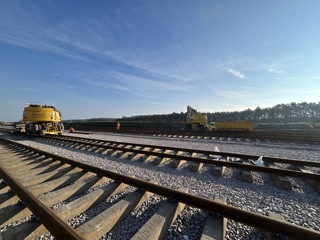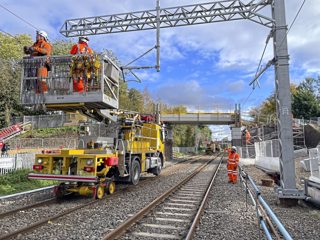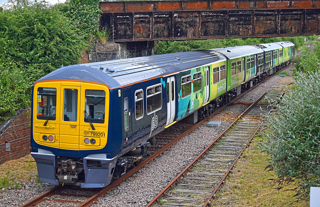Billions of pounds are being invested in London’s railways. New infrastructure and new trains are on order, and in the past few years Transport for London has transformed commuter travel for millions with its Overground operations.
One of the biggest projects is Thameslink. Yet this £6 billion scheme has taken something of a backseat in recent years - instead the headlines have been grabbed by Crossrail with its tunnel progress and new train orders, by London Overground with its record-breaking performance, and even by High Speed 2 and the debate over its station locations. The Thameslink scheme, started in 2008, has seemingly been overlooked.
And yet so much has already been achieved. Twelve-car trains now run through what is the only north-south direct heavy rail route through the centre of London; after months of dallying, the train order is finally progressing; the Department for Transport has specified the contract for the franchise that will run the train service; and new stations at Blackfriars (spanning the River Thames) and Farringdon are open. Further afield, stations on the Midland Main Line can now accommodate longer trains.
At peak times there are now 8,000 additional seats. Twenty-three brand new Class 377/5s have been introduced, supplemented by three slightly older Class 377/2s that have moved from Southern. (A further six will follow in time for the May timetable.)
In addition, the frequency through the centre of London has more than doubled, from seven trains per hour to 15tph; new destinations (including Sevenoaks, Rochester and Ashford) have been added to the TL network, and new 12-car sidings have opened at Bedford.
But all this has not been achieved easily. For two and a half years - between December 2009 and May 2012 - there were cross-London closures at nights and weekends. From December 20 this year, TL trains will not serve London Bridge for three years. And a nine-day blockade is planned this August, affecting First Capital Connect and Southern trains (there are four working days in this period).
Jonathan Bridgewood, the Thameslink director for First Capital Connect, is responsible for ensuring the plans work. He describes the ‘Core’ between St Pancras and Blackfriars as “a sponge”, explaining: “It soaks all the trains up. The key thing is, for me, Thameslink is not just trains, it is system integration, too. We have to work with Network Rail and the supply base to make sure it all works.”
Bridgewood tells RAIL that the first of the new Siemens Class 700s will arrive from Germany in August 2015, and will be accepted for passenger traffic by the end of that year.
Infrastructure-wise, as well as brand new depots at Hornsey and Three Bridges, there will be remodelling work at Cricklewood depot and new sidings at Peterborough. Additional sidings will also be available at Three Bridges.
Hornsey has been a challenge, he says. “Coronation Sidings is the Siemens depot. The whole yard is being rebuilt and remodelled, and yet Hornsey is still running. We are the operator - it won’t be Siemens. There are different obligations. Siemens will do the maintenance, whereas we will operate the depot and the trains.”
The trains may have been ordered while FCC is still in charge of running the TL network, but FCC will not actually operate them. That’s because the new Thameslink, Southern & Great Northern (TSGN) mega-franchise should (in theory) begin this September.
So why does Bridgewood refer to it as ‘we’?
“We signed the contract. The pen was in my hand. The contracts were in place with us. The new TSGN takes over the contracts. I class this as a road bump.”
He says a dedicated team has been set up at FCC, to deal with Thameslink. “For me, it is business as usual.”
The reason for ordering the new trains is that running 24 trains per hour needs Automatic Train Operation (ATO). However, the Class 377s, the most modern train on the TL network, will not be fitted with it.
“With conventional signalling you can get up to 20tph,” says Bridgewood.
The 24tph plan is through the ‘core’ section of the TL network. Sixteen trains will run on the existing route, while eight will head on to the Great Northern section. “It saturates at 30tph,” he says.
Can ‘the core’ take 30tph? The answer is a positive one.
Bridgewood continues: “There’s so much time between the headways. There is a system to bring a controlled stop. Then the doors must be released and open. The human element introduces delay, so the computer does it.
“You have to break down the various elements. There are wider doors on the new trains, and less seating. We have taken away the 3+2 seating because nobody liked it. Also, it allows a wider aisle.”
Access on these trains is important because they serve airports as well as commuter routes.
Bridgewood asks some interesting questions: “What is the primary reason for Thameslink? Capacity improvements. What are the demographics? We have two airports, Crossrail and Farringdon. There will be inner and outer suburban routes. That has been a massive challenge, so 24tph is important for the programme.”
The relationship with Network Rail is also vital, he says.
“How do you support resilience? One challenge is that TL is like a pipe through the centre of London. The final timetables for the Core haven’t been finalised yet - we have to make sure the capabilities for what is needed are there. But there has been progress. The work on the Canal Tunnels has been done, but there is more needed.”
In order to create what is, in effect, almost a new railway, these have been painful times for passengers. FCC admits that. And there is more to come. Bridgewood says it is about how this is managed.
“It involves FCC, the Northern Line, East Midlands Trains, Network Rail, Transport for London - because they are all affected. We are looking at the optimum solution because we have to break the railway to reconfigure it.
“It is going to be painful, we recognise that. It is about adopting a position that is right for the passenger.
“There is a group for capacity management. Where does the capacity move to, and from? We need to keep the trains at 12-cars because we are reducing capacity on some routes. We are working with 12-car trains, and the solutions on diagrams are being worked on.”
Bridgewood wonders about travel demand management, and says TfL is helping here. A website that was used by TfL during the 2012 Olympic Games, to broadcast the capacity issues the industry faced then, is being resurrected to communicate to passengers the disruption caused by the three-year closure to TL trains of London Bridge.
“What we have to do is give people information to make the decisions regarding travel,” he says. “When the railway runs right it is fantastic. When it goes wrong it affects a lot of people. People need the right information.” He says that communications regarding the delays and diversions have already begun.
Looking at the future, TSGN is likely to keep the Class 365s, as the new trains will not be able to run everywhere.
“We have 828 vehicles, and the order is for 1,140. They do not replace everything. We may keep the ‘365s’.”
The TL network is ever changing, with London Bridge at the start of a radical transformation programme that, when complete, will mark the end of a decade-long £6 billion investment into London’s
railways.

















Login to comment
Comments
No comments have been made yet.